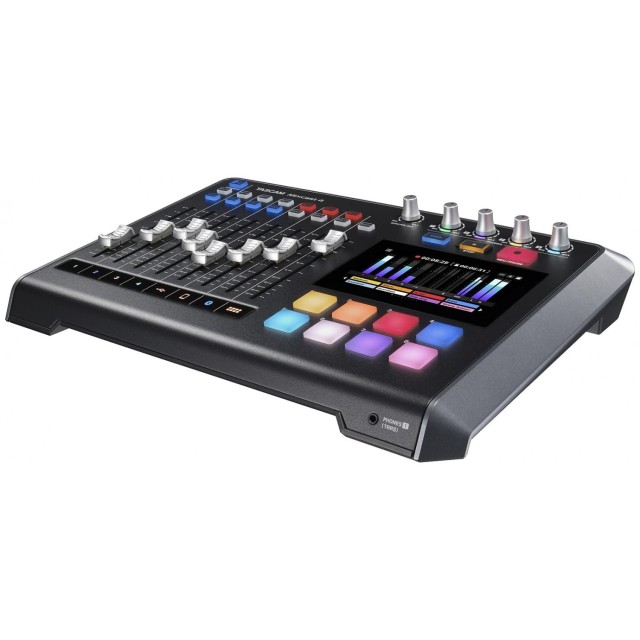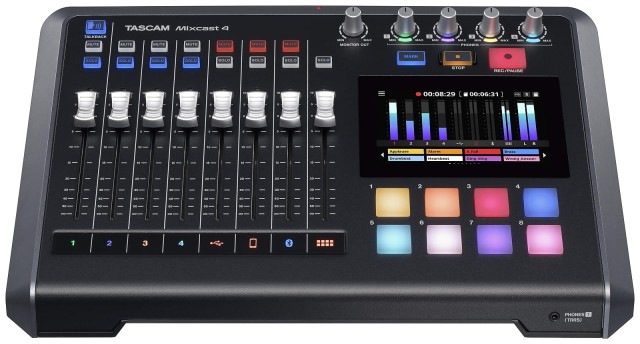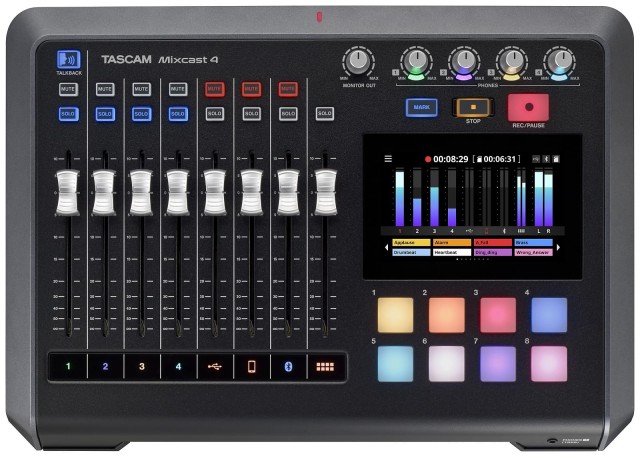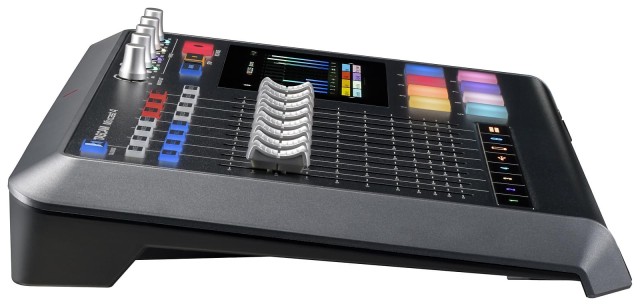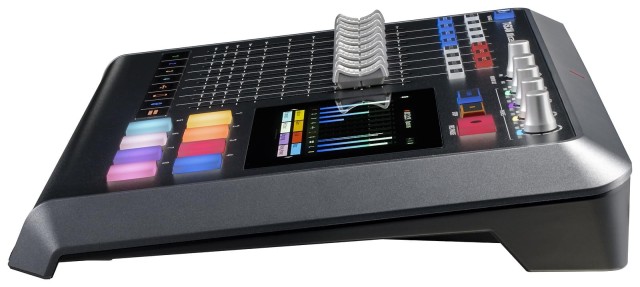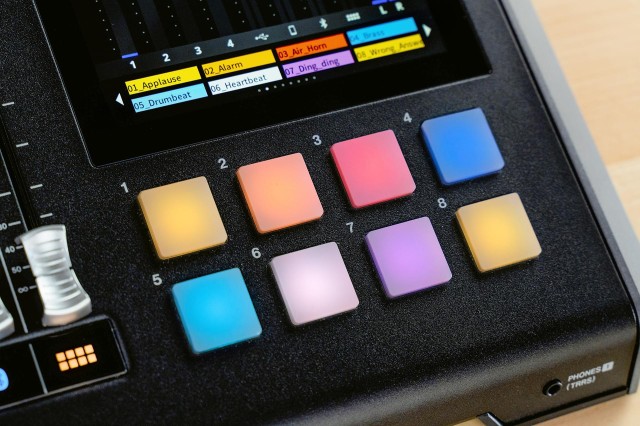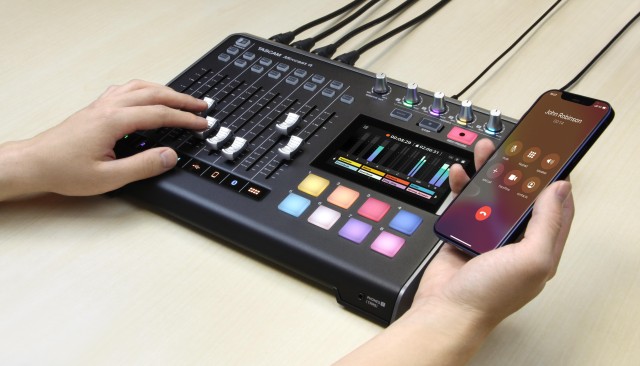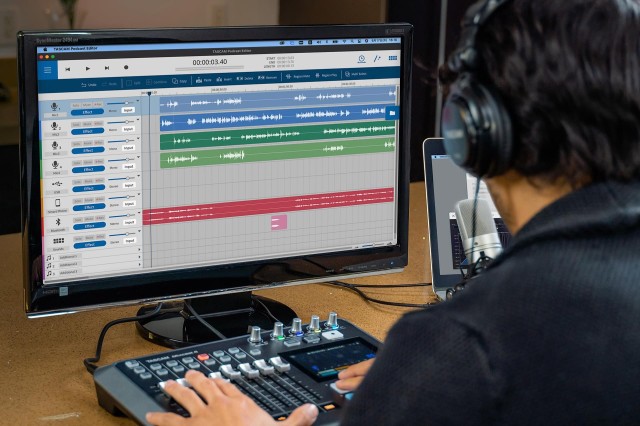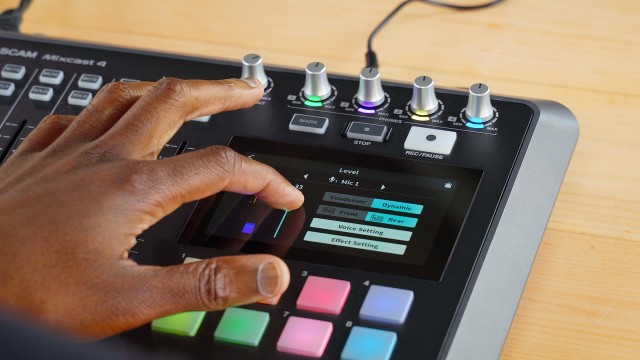
- Search
-
Login
-
0
ComparisonAdd products to compare, then they will appear here and you can compare parameters.
-
0
0 €Nothing in the basket.
Tascam Mixcast 4 Content Production Station
All you need for successful Podcast Creation Audio creation made easy Mixcast 4 makes professional content creation easy. For podcast creation, live streaming, event production or voice over, Mixcast 4 can mix and record mic input with internal background music, effect sounds and jingles via the trigger pads, and external audio input from your phone, PC or…
Shipment day: 07. 04.
Praha 1 pcs
DISCOUNTED SETS (2)
Top accessories for Tascam Mixcast 4 Content Production Station
Product description
All you need for successful Podcast Creation Audio creation made easy Mixcast 4 makes professional content creation easy. For podcast creation, live streaming, event production or voice over, Mixcast 4 can mix and record mic input with internal background music, effect sounds and jingles via the trigger pads, and external audio input from your phone, PC or Bluetooth device. Together with the Tascam Podcast Editor software you get a complete package including waveform editing and multi-track recording for all work steps from pre-production to completion.
Stress-free touch panel control
Equipped with four mic inputs and four individual headphones outputs, the Mixcast 4 is always ready for podcast production without complicated settings. It provides all audio-related operation and workflow needed for live-streaming, events, podcasts, and other applications. The auto-mixing function, for example, can automatically adjust optimal levels and set mic priority for a perfect mix.
And thanks to the 5-inch colour touch screen, you can intuitively access the well-structured menu and make the desired settings with just a few simple steps.
A complete workstation with all the functions you need
From audio recording to the mixing of recorded audio, the Mixcast 4 offers a complete production environment with multiple convenient functions such as 14-track recording direct to the unit’s SD card, Bluetooth audio input, an Aux input connector to easily mix and record phone conversations (with mix-minus) or other sound sources, and USB connectivity that allows the unit to add sounds from a computer.
You can even use Mixcast 4 as a 14-in/2-out USB audio interface with your favourite DAW software.
Enhance content with real-time sound effects
The Mixcast 4 comes with eight banks of fully customisable, illuminated sound pads which can be triggered during a podcast production or live broadcast. In addition to preset sound effects, users can flexibly assign new sounds, music or even mic sounds that have been pre-recorded on the unit.
The Mixcast 4 sound pads also allow for easy and on-time voice effects such as pitch transformation, reverb and more to make live streams and recordings even more interesting and fun.
Tascam Podcast Editor available for post-editing and control
The Tascam Podcast Editor offers simple and practical editing of audio content, track arming, as well as easy configuration and assignment of sound effects and background music to the sound pads.
There’s no need for expert knowledge on DAW software as Podcast Editor also offers intuitive graphics that will help users record audio easily using the Mixcast 4. Tascam Podcast Editor is designed specifically for Mixcast 4 and is available for both computers and mobile devices.
Features at a glance
- Production of podcasts with up to four people: 4 mic inputs with auto-mix, 4 headphones outputs
- Invite guests and friends: Mix-Minus to include call-ins with echo-free audio via Bluetooth, USB input or 4-pole TRRS audio cable
- Sound pads for instant sound triggering and effects
- Easy and intuitive control using a 5-inch touchscreen
- Fully compatible with the dedicated Tascam Podcast Editor software to cover the entire production workflow
- Records up to 14 tracks directly to an SD card (12 channels + stereo mix)
- Built-in USB audio interface with 14 inputs and two outputs
- Nine language options including English, French, German, Italian, Spanish, Russian, Chinese, Japanese and Korean
Hardware
- Four mic inputs over balanced XLR/TRS combo jacks
- Four headphones outputs with independent volume controls
- Headset input/output via 3.5-mm TRRS mini-jack (mirrors the output of headphones output 1)
- Stereo line input, selectable between dual balanced TRS jacks and a 3.5-mm TRRS jack
- Balanced monitor outputs via dual TRS jacks
- Stereo line output via 3.5-mm stereo mini-jack
- Eight Sound Pad buttons
- Use these to instantly play effect sounds, jingles, background music or other audio material
- Eight sound banks available for up to 64 sounds in total
- Quickly switch between the eight sound banks via the touchscreen
- One bank of sounds included (can be set with Podcast Editor)
- Eight large channel faders to mix the levels of
- four mic signals
- one stereo signal via USB
- one stereo signal from a mobile device
- one stereo signal via Bluetooth
- the Sound Pad sounds
- Mute and Solo buttons on each channel (sound pad channel: Solo only)
- Talkback button for announcements to the podcast participants
- Mark button to set marks for specific events or phases of the podcast during recording
- Powered by low-noise DC 12 V (AC adapter with screw lock included as standard)
Software settings and processing
- Mic channels:
- Selection between Condenser (with 48 V phantom power) and Dynamic
- Easy sound settings (Deep, Mid, Bright) or manual setting (two-band semi-parametric EQ), switchable on/off
- Easy compressor settings (Soft, Hard) or manual setting with five parameters, switchable on/off
- De-esser (three parameters) and noise supressor (five parameters)
- Reverb (one mic channel only) with easy settings (Small, Medium, Large) or manual setting (five room types, three parameters), switchable on/off
- USB, smartphone, Bluetooth stereo channels:
- De-esser (three parameters) and noise supressor (five parameters)
- Easy audio enhancement settings (Talk, Music, Off)
- Feature to play back, check, rename or delete recorded audio files
- Sound pads:
- Select from six different methods of how sound pad sounds are played
- Record sound pad sounds
- Audio settings:
- USB Mix-Minus on/off
- Feedback prevention on/off
- Line level output on/off
- Solo mode pre/after fader
- Display brightness, Auto power-off
- Adjustable time delay for the USB output signal to compensate for any time delay between the unit’s audio and video signals played from a computer (0–2000 ms)
- SD cards can be erased (quick or full erase) and used as a mass-storage device via USB
- Bundled with dedicated TASCAM Podcast Editor application to cover the entire system workflow
- Load audio files into Mixcast 4 to use them for the Sound Pads
- Load recorded Podcasts from Mixcast 4 for editing and archiving
- Record multiple audio tracks with your computer or mobile device
New features with firmware v1.20
- A new Common Mode enables a mic input effect to be shared by multiple mic channels
- Effects can now be turned on/off for individual mics on the home screen
- The ducking effect can now also be used with pad playback sounds
- The input level for the USB, smartphone and Bluetooth inputs can now be adjusted
- Modified operation of the feedback prevention function
- Switchable decibel scale for the level meters
- Tapping on a channel on the main page calls up the corresponding settings page
New features since firmware version 1.30
- Improvements for sound pads
- Sound pad banks can now be changed and used during recording
- The playback volume can now be adjusted for each sound pad separately
- Sounds assigned to sound pads can now be normalised
- The volume of the Bleep sound can now be adjusted
- The talkback sound can now also be sent to USB, smartphone and Bluetooth connections
PACKAGE CONTENT
Mixcast 4
SPECIFICATIONS
| Recorder specifications | |
|---|---|
| Recording media | SD cards (64 MB – 2 GB) SDHC cards (4–32 GB) SDXC cards (48–512 GB) |
| Recording/playback format | WAV, 48 kHz, 24 bit, 2-channel stereo / 14-channel poly (BWF) |
| Approximate recording times with 16-GB SD card (in hours:minutes) | |
| Stereo recording | 16:30 |
| 14-track recording | 2:20 |
Analogue audio inputs |
|
|---|---|
| Mic inputs 1-4 | XLR/TRS combo jacks XLR-3-31 (1: GND, 2: HOT, 3: COLD) 6.3-mm standard TRS jacks (Tip: HOT, Ring: COLD, Sleeve: GND) |
| Maximum input level | +10 dBu (when LEVEL at min.) |
| Nominal input level | −10 dBu (when LEVEL at min.) |
| Minimum input level | −76.5 dBu (when LEVEL at max.) |
| Gain range | 66.5 dB |
| Input impedance | 2.1 kΩ |
| Headset input (TRRS, CTIA standard) | 3.5-mm, 4-pole mini jack |
| Maximum input level | +4 dBV (when LEVEL at min.) |
| Nominal input level | −16 dBV (when LEVEL at min.) |
| Minimum input level | −82.5 dBV (when LEVEL at max.) |
| Gain range | 66.5 dB |
| Input impedance | 2 kΩ |
| Line input (TRRS, CTIA standard) | 3.5-mm, 4-pole mini jack |
| Maximum input level | +8 dBV |
| Nominal input level | −12 dBV |
| Input impedance | 12 kΩ |
| Line inputs L/R (balanced) | 6.3-mm standard TRS jacks (Tip: HOT, Ring: COLD, Sleeve: GND) |
| Maximum input level | +24 dBu |
| Nominal input level | +4 dBu |
| Input impedance | 11 kΩ |
Analogue audio outputs |
|
|---|---|
| Phones outputs 1-4 | 6.3-mm standard stereo jacks |
| Maximum output power | 45 mW + 45 mW (0.1% THD+N or less, 32 Ω) |
| Working impedance | 16–600 Ω |
| Headset output (TRRS) | 3.5-mm, 4-pole mini jack (signal mirrors Phones 1 output) |
| Line output (TRRS, CTIA standard) | 3.5-mm, 4-pole mini jack |
| Maximum output level | −25 dBu |
| Nominal output level | −45 dBu |
| Output impedance | 100 Ω |
| Monitor output L/R (balanced) | 6.3-mm standard TRS jacks (Tip: HOT, Ring: COLD, Sleeve: GND) |
| Maximum output level | +20 dBu |
| Nominal output level | 0 dBu |
| Output impedance | 200 Ω |
| Line output | 3.5-mm stereo mini jack |
| Maximum output level | +6 dBV |
| Nominal output level | −14 dBV |
| Output impedance | 200 Ω |
USB port |
|
|---|---|
| Connector | USB Type-C |
| Transfer format | USB 2.0 High Speed |
| Device class | USB Mass Storage Class USB Audio Class 2.0 |
| USB audio | Sampling rate: 48 kHz Bit depth: 24 bit Inputs: 14 channels (output from Mixcast 4) Outputs: 2 channels (input to Mixcast 4) |
Audio performance |
|
|---|---|
| Equivalent input noise, mic inputs | ≤−125 dBu (150 Ω termination, LEVEL at max.) |
| Frequency response (mic inputs 1–4) | 20 Hz – 20 kHz: ±0.3 dB (JEITA) |
| S/N ratio (mic in 1–4) | 101 dB (channel faders at 0, 20 kHz SPCL LPF, A-weighted) |
| Distortion (mic in 1–4) | 0.003 % (1 kHz sine wave, channel faders at 0, 20 kHz SPCL LPF) |
| Crosstalk | ≥95 dB |
| Note: Measurement conditions conform to JEITA CP-2905B. |
Bluetooth |
|
|---|---|
| Output class | Class 2 (approx. 10 m* unobstructed transmission distance) |
| Supported profile | A2DP |
| Supported A2DP codecs | SBC, AAC |
| Supported A2DP content protection | SCMS-T |
| Computer hardware requirements | |
|---|---|
| Windows | Windows computer with a USB 2.0 (or higher) |
| CPU/processor speed | 2 GHz or faster dual core processor (x86) |
| Memory | 2 GB or more |
| Mac | Mac computer with a USB 2.0 (or higher) |
| CPU/processor speed | 2 GHz or faster dual core processor |
| Memory | 2 GB or more |
Power supply and other |
|
|---|---|
| Power supply | Dedicated AC (PS-P1220E NUT), DC 12 V |
| Power consumption | 12.5 W (maximum) |
| Weight | 2.55 kg |
| Permissible operating temperature range | 0–40 °C |
| Dimensions (W × H × D) | 375 mm × 57 mm × 264 mm (excluding protrusions) 375 mm × 71 mm × 267 mm (overall) |
SDHC/SDXC
| Manufacturer | Model | Part No. | Capacity |
|---|---|---|---|
| Tascam | Tascam SD | TSQD-32A | 32 GB |
| Kioxia | Exceria Pro UHS-II NEW | KSDXU-A064G | 64 GB |
| KSDXU-A128G | 128 GB | ||
| Exceria Basic UHS-1 | KSDB-A016G | 16 GB | |
| KSDB-A032G | 32 GB | ||
| KSDB-A064G | 64 GB | ||
| KSDB-A128G | 128 GB | ||
| SanDisk | Ultra (Eco package) NEW | SDSDUN4-032G-GHENN | 32 GB |
| SDSDUN4-064G-GHENN | 64 GB | ||
| SDSDUN4-128G-GHENN | 128 GB | ||
| SDSDUN4-256G-GHENN | 256 GB | ||
| Extreme Pro (Eco package) NEW | SDSDXDK-032G-GHEIN | 32 GB | |
| Extreme | SDSDXVE-032G-GHENN | 32 GB | |
| SDSDXV6-064G-GHENN | 64 GB | ||
| Extreme Pro UHS-I | SDSDXPA-512G-G46 | 512 GB | |
| Sony | SF-UY3 Series | SF-128UY3/T | 128 GB |
| Transcend | SDHC/SDXC 420T NEW | TS32GSDC420T | 32 GB |
| TS64GSDC420T | 64 GB | ||
| TS128GSDC420T | 128 GB | ||
| TS256GSDC420T | 256 GB | ||
| TS512GSDC420T | 512 GB | ||
| SDXC/SDHC 10M NEW | TS16GSDHC10M | 16 GB | |
| TS64GSDHC10M | 64 GB |
Parameters
ACCESSORIES (10)
RODE Studio Arm PSA1
RODE HJA-4 -3.5mm to ¼-inch Headphone Adaptors
K&M Table microphone stand KaM 232
Synco CMic-V1
SYNCO MA38
Sennheiser MK 4
EQ ACOUSTICS Classic Wedge 30X30X5 GREY (16pcs)
Tascam TM-80 Studio Condenser Microphone
Lewitt LCT 441 FLEX
Tascam CS-PCAS20
DISCOUNTED SETS (2)
small podcast studio A1
Set description
- 3x Panasonic AG-CX350
- 3x Manfrotto MVH502A,546GB-1
- 20m SDI cable, XLR audio cable
- 1x SENNHEISER 4 CHANNEL UHF WIRELESS MICROPHONE SET
- 1x SENNHEISER HD 200 PRO headphones
- 3x SMALLRIG RC220B studio light, 2x SMALLRIG RC120B studio light, 3x SMALLRIG softbox
- 5x AVENGER C-STAND KIT 33 BLACK FINISH VERSION, 5x sandbag
In addition to P2 MXF format support, the broadcast version of the CX10 also offers 3G-SDI output (also valid for HC-X2000), as well as an Ethernet interface (with included micro USB > LAN adapter) with NDI|HX support (requires optional license). On sale from end of 3/2020.
read morelesspodcast studio CAST-150
Set description
- 2x camera, 2x tripod, 3x studio light, 3x light stand
NDI|HX (vyžaduje volitelnou licenci). V prodeji od 1/2023.
read moreless- Show all

Tascam Mixcast 4 Content Production Station
All you need for successful Podcast Creation Audio creation made easy Mixcast 4 makes629 €In stock 1 pcs


